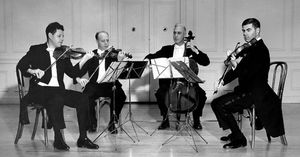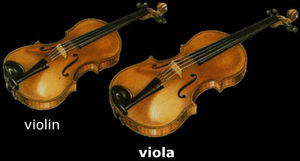| |
String quartet
Music Sound
String quartet
 The resident string quartet of the
Library of Congress in 1963
The resident string quartet of the
Library of Congress in 1963A string quartet is a
musical ensemble of four
string instruments—usually two violins, a viola and cello—or a piece written
to be performed by such a group.
Background
 Close-up photo of a violin. A string quartet usually has two violinists.
Close-up photo of a violin. A string quartet usually has two violinists.
Although any combination of four string instruments can literally be called a
"string quartet", in practice the term refers to a group consisting of two
violins (the
"first", which usually plays the melody line in the higher register of notes,
and the "second" violin, which plays lower notes in harmony), one
viola and one
cello. Should a
composer create music for four other string instruments — for instance, three
violins and a bass, or violin, viola, cello and guitar — the instrumentation is
indicated specifically. The standard string quartet is widely seen as one of the
most important forms in
chamber music, with most major composers, from the late
18th
century onwards, writing string quartets.
A piece of music for four players of stringed instruments may be in any form,
but if it is simply a String Quartet (with or without a subtitle) it is
usually in four movements, with a large-scale structure similar to that of a
symphony. The outer movements are
typically fast, the inner movements in classical quartet form are a slow
movement and a dance movement of some sort (e.g., minuet, scherzo,
furiant), in either order.
Many other chamber groups can be seen as modifications of the string quartet,
such as the
piano
quintet, which is a string quartet with an added
piano; the
string quintet, which is a string quartet with an extra viola, cello or
double bass; the
string
trio, which contains one violin, a viola, and a cello; and the
piano
quartet, a string quartet with one of the violins replaced by a piano.
History
 Violin and viola
Violin and viola
The form first came to be used after the middle of the
18th century. Joseph Haydn's first works for string quartet have five movements
and resemble the divertimento (a title which they carried in some editions) or
serenade,
but the opus 9 quartets of 1769–70 are in the form which was to become standard
both for Haydn and for other composers: four movements, a fast movement, a slow
movement, a minuet and trio and a fast finale. Because his example helped codify
a form that originated in the Baroque
suite, Haydn is
often referred to as "the father of the string quartet." Haydn occasionally
played his quartets on social occasions in an impromptu quartet ensemble of
which
Mozart was also a member.
Ever since Haydn's day, the string quartet has been prestigious, and
considered a true test of the classical composer's art. This may be partly due
to the fact that the palette of sound is more restricted than with
orchestral
music, forcing the music to stand more on its own rather than relying on tonal
color; or from the inherently
contrapuntal tendency in music written for four equal instruments.
Quartet composition flourished in the
Classical era, with both
Mozart and Beethoven writing famous series of quartets to set alongside Haydn's. A -
very slight - slackening in the pace of quartet composition occurred in the 19th
century; here, a curious phenomenon was seen in composers who wrote only one
quartet, perhaps to show that they could fully command this hallowed genre. With
the onset of the Modern era of classical music, the quartet returned to full
popularity among composers, as the extensive listings below document.
Popular string quartets
Some of the most popular or widely acclaimed works for string quartet written
between the 18th century and the 1980s, include:
Joseph Haydn's 68 string quartets, especially the late Erdody Quartets,
Op. 76.
Wolfgang Amadeus Mozart's 23 string quartets: the six he dedicated to Haydn
in particular (K. 387, 421, 428, 458, 464, 465, Opus 10) are generally
considered to be the pinnacle of the classical quartet form. String Quartet
No. 19 in C major ("Dissonance"), K. 465 is still surprising for its
dissonant opening.
The sixteen quartets of Ludwig van Beethoven are highly acclaimed. The
String Quartets Nos. 1-6, Opus 18 are thought to demonstrate his total
mastery of the classical string quartet as developed by Haydn and Mozart.
The next three, or the Razumovsky Quartets are extremely popular even today,
as they greatly expanded the form and incorporated a new degree of emotional
sensitivity and drama. These were followed by String Quartets Nos. 10 - 11,
Opus 74 "Harp" and 95 "Serioso" (Beethoven). Finally, the Late Beethoven
String Quartets, which group includes his last five quartets and the Große
Fuge, are the composer's last completed works. Though these works are widely
considered to be among the greatest musical compositions ever written, their
uncompromising intellectual complexity and their apparent rejection of the
romantic pathos which pervades Beethoven's middle period both ensure that
they remain considerably less popular than the Razumovsky quartets.
Franz Schubert's String Quartet No. 14 in D Minor "Death and the Maiden".
Also his String Quartet No. 13 in A Minor "Rosamunde" and his final String
Quartet No. 15 in G Major
The six string quartets of Felix Mendelssohn
Bedřich Smetana's String Quartet No. 1 in E Minor "From my Life"
The three quartets by Johannes Brahms
Antonín Dvořák's "American" String Quartet No. 12 in F Major
Peter Tchaikovsky's String Quartet No. 1 in D Major, Op. 11, especially the
second movement "Andante cantabile."
Alexander Borodin's String Quartet No. 2 in D Major, especially the third
movement "Notturno."
Claude Debussy's String Quartet in G Minor, op. 10
The four string quartets by Arnold Schoenberg
Maurice Ravel's String Quartet in F Major
Leoš Janáček's String Quartet No. 1 "Kreutzer", inspired by Tolstoy's The
Kreutzer Sonata, which in turn was inspired by Beethoven's Violin Sonata No.
9, the "Kreutzer Sonata."
Frank Bridge's String Quartet No. 3
The six string quartets by Béla Bartók
Alban Berg's Lyric Suite, originally composed for string quartet
Bohuslav Martinů's Concerto for String Quartet and Orchestra
The fifteen string quartets of Dmitri Shostakovich, especially String
Quartet No. 8 in C Minor, Op. 110
Elliott Carter's five string quartets are among the most widely acclaimed
series in recent years
Toru Takemitsu's Quartet No. 1 for Strings "A Way a Lone'
Further reading
David Blum (1986). The Art of Quartet Playing: The Guarneri Quartet in
Conversation with David Blum, New York: Alfred A. Knopf Inc. ISBN
0394539850,
Arnold Steinhardt (1998).Indivisible by four, Farrar, Straus Giroux. ISBN
0374527008
Edith Eisler (2000). 21st-Century String Quartets, String Letter Publishing.
ISBN 1890490156
Paul Griffiths (1983). The String Quartet: A History, New York: Thames and
Hudson. ISBN 050001311X
David Rounds (1999), The Four & the One: In Praise of String Quartets, Fort
Bragg, CA: Lost Coast Press. ISBN 1882897269.
External links
Home | Up | Minimalist music | Overture | Piano concerto | Piano sonata | Piano trio | Process music | String quartet
Music Sound, v. 2.0, by MultiMedia
This guide is licensed under the GNU
Free Documentation License. It uses material from the Wikipedia.
|
|







